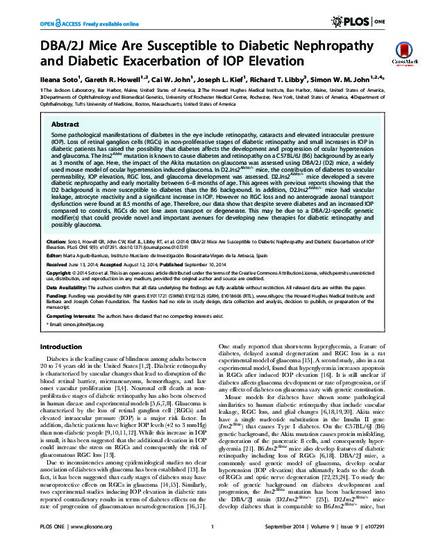
Some pathological manifestations of diabetes in the eye include retinopathy, cataracts and elevated intraocular pressure (IOP). Loss of retinal ganglion cells (RGCs) in non-proliferative stages of diabetic retinopathy and small increases in IOP in diabetic patients has raised the possibility that diabetes affects the development and progression of ocular hypertension and glaucoma. The Ins2Akita mutation is known to cause diabetes and retinopathy on a C57BL/6J (B6) background by as early as 3 months of age. Here, the impact of the Akita mutation on glaucoma was assessed using DBA/2J (D2) mice, a widely used mouse model of ocular hypertension induced glaucoma. In D2.Ins2Akita/+ mice, the contribution of diabetes to vascular permeability, IOP elevation, RGC loss, and glaucoma development was assessed. D2.Ins2Akita/+ mice developed a severe diabetic nephropathy and early mortality between 6–8 months of age. This agrees with previous reports showing that the D2 background is more susceptible to diabetes than the B6 background. In addition, D2.Ins2Akita/+ mice had vascular leakage, astrocyte reactivity and a significant increase in IOP. However no RGC loss and no anterograde axonal transport dysfunction were found at 8.5 months of age. Therefore, our data show that despite severe diabetes and an increased IOP compared to controls, RGCs do not lose axon transport or degenerate. This may be due to a DBA/2J-specific genetic modifier(s) that could provide novel and important avenues for developing new therapies for diabetic retinopathy and possibly glaucoma.
Soto, I., Howell, G. R., John, C. W., Kief, J. L., Libby, R. T., & Simon W M John. (2014). DBA/2J mice are susceptible to diabetic nephropathy and diabetic exacerbation of IOP elevation. PloS One, 9(9), e107291.

Copyright: © 2014 Soto et al. This is an open-access article distributed under the terms of the Creative Commons Attribution License, which permits unrestricted use, distribution, and reproduction in any medium, provided the original author and source are credited.